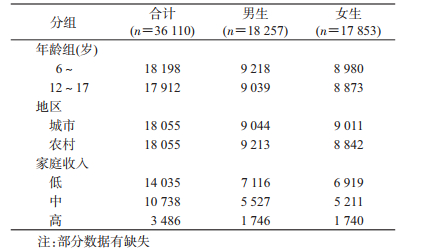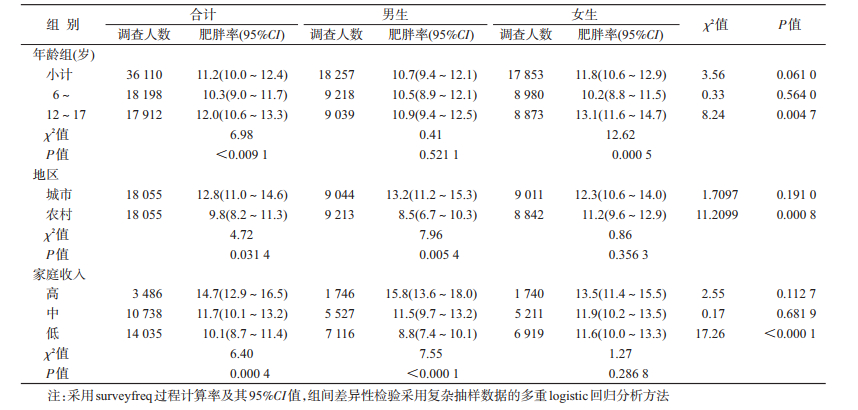文章信息
- 房红芸, 刘丹, 赵丽云, 于冬梅, 张倩, 于文涛, 翟屹, 赵文华.
- Fang Hongyun, Liu Dan, Zhao Liyun, Yu Dongmei, Zhang Qian, Yu Wentao, Zhai Yi, Zhao Wenhua.
- 中国6~17岁儿童青少年腰围水平及中心性肥胖流行特征
- Epidemiological characteristics of waist circumference and abdominal obesity among Chinese children and adolescents aged 6-17 years
- 中华流行病学杂志, 2018, 39(6): 715-719
- Chinese Journal of Epidemiology, 2018, 39(6): 715-719
- http://dx.doi.org/10.3760/cma.j.issn.0254-6450.2018.06.004
-
文章历史
收稿日期: 2018-02-23
2. 102206 北京, 中国疾病预防控制中心慢性病防治与社区卫生处
2. Division of Non-communicable Diseases Control and Community Health, Chinese Center for Disease Control and Prevention, Beijing 102206, China
目前,在世界范围内儿童青少年超重肥胖率急剧增长,已成为各国学者密切关注的公共卫生问题[1]。关于儿童青少年超重肥胖的筛查,使用最多的测量指标是BMI[2],腰围是一个很好的评估儿童少年腹部脂肪含量的指标,近年越来越多地被用来筛查儿童青少年腹型肥胖即中心性肥胖[3-4]。本研究利用“2010—2012年中国居民营养与健康状况监测”数据,分析我国6~17岁儿童青少年腰围水平及中心性肥胖流行特征,为儿童青少年超重和肥胖防治策略制定提供科学依据。
资料与方法1.资料来源:利用“2010—2012年中国居民营养与健康状况监测”中6~17岁儿童青少年调查资料。该调查采用多阶段分层整群随机抽样的方法,将县级行政单位分为4类,即大城市、中小城市、普通农村和贫困农村。第一阶段从4类地区共抽取150个县级单位作为监测点;第二阶段每个监测点等距抽取6个村(居)委会;第三阶段每个村(居)委会采用简单随机抽样方法抽取75户,≥6岁家庭成员参加调查[5]。为了保证儿童青少年样本量的要求,在样本地区的中小学校适当补充了儿童青少年人群,其中每个监测点6~17岁儿童青少年不少于240名,每个年龄组人数不低于20名,本研究纳入分析的有效分析样本量为36 110名。本监测通过中国CDC营养与健康所伦理审查委员会批准(批准文号:2013-018),所有调查对象由家长签署知情同意书。
2.调查方法:①问卷调查:采用自行设计并经专家论证和调查表收集调查对象的基本信息,包括性别、出生日期、民族、家庭经济收入等,由培训合格的调查员通过面对面调查的方式进行问卷调查。②体检:采用集中体检的方式,腰围测量均由经过统一培训并考核合格的调查员按照标准的测量步骤进行。使用国家项目组指定腰围尺,精确到0.1 cm。
3.判定标准:①中心性肥胖:采用国内相关研究推荐的腰围P90(同年龄、同性别)作为中心性肥胖的判断界值[6]。②家庭经济收入水平划分:根据家庭年人均收入水平(万元)分为高(>2.5)、中(1~)、低(<1)3组[7]。
4.统计学分析:采用SAS 9.4软件进行统计学分析,对数据进行复杂抽样加权调整[7],权重包括抽样权重和事后加权权重,事后加权以国家统计局提供的2009年全国人口数据为标准。将年龄、性别、城乡、经济水平等作为分层因素,腰围水平采用surveymeans过程计算x及sx,中心性肥胖率采用surveyfreq过程计算率及其95%CI。腰围的组间差异性检验采用复杂抽样数据的多重线性回归分析方法;中心性肥胖率的组间差异性检验采用复杂抽样数据的多重logistic回归分析方法。
结果1.一般特征:纳入6~17岁儿童青少年36 110人,其中男生18 257人(城市9 044人,农村9 213人),女生17 853人(城市9 011人,农村8 842人)。见表 1。
2.腰围水平:我国6~17岁男生、女生腰围均随着年龄增长而增加,女生腰围在15岁时增长开始放缓,而男生持续增长。各年龄组儿童青少年腰围均为男生大于女生(P<0.000 1),城市高于农村(P<0.05),家庭收入水平高的儿童青少年的腰围高于中、低家庭收入儿童(P=0.000 3),中、低家庭收入儿童青少年的腰围差异无统计学意义。见表 2。
3.儿童青少年中心性肥胖情况:我国6~17岁儿童青少年中心性肥胖率为11.2%,其中12~17岁儿童中心性肥胖率(12.0%)高于6~11岁儿童(10.3%),差异有统计学意义(P<0.000 1)。男生和女生中心性肥胖率分别为10.7%和11.8%,差异无统计学意义(P>0.05),其中12~17岁女生中心性肥胖率为13.1%,高于同年龄组男生(10.9%),差异有统计学意义(P<0.05)。城市6~17岁儿童青少年中心性肥胖率为12.8%,高于农村儿童青少年(9.8%),差异有统计学意义(P<0.05),男生中心性肥胖率城乡差异有统计学意义(P<0.05),女生城乡差异无统计学意义(P>0.05)。城市儿童青少年中心性肥胖率性别差异无统计学意义(P>0.05),而农村女生中心性肥胖率高于农村男生,差异有统计学意义(P<0.05)。男生家庭收入水平越高,其中心性肥胖率越高(P<0.000 1),而不同家庭收入水平女生的中心性肥胖率差异无统计学意义(P>0.05)。低家庭收入女生中心性肥胖率(11.6%)高于低家庭收入男生(8.8%),差异有统计学意义(P<0.000 1)。见表 3。
腰围作为评价中心性肥胖的指标,近年来越来越受到人们的重视,作为诊断成年人MS的前提条件[8],已经被广泛应用于成年人群的健康评价。腰围也是儿童青少年MS的评价指标之一[9-10]。早在2005年,WHO神户肥胖会议就提出,将使用腰围筛查儿童中心性肥胖作为今后工作的重点。由于不同种族儿童生长发育过程及体脂肪蓄积模式不同,各国应制定本国儿童超重肥胖的腰围判断界值。国外大部分研究均采用P90作为儿童腰围界值点[11]。国际糖尿病联盟推荐的儿童MS标准也以P90作为界值[9],但我国这方面的研究较少。国内相关研究推荐预测我国儿童少年心血管危险因素明显增加的腰围界限值为年龄别、性别的P90[6]。但我国还没有明确儿童青少年中心性肥胖腰围界值的标准。因此,本研究采用腰围的P90作为中心性肥胖的判断界值,分析我国儿童青少年中心性肥胖流行特征,并期待为我国儿童中心性肥胖的研究提供依据和支持。
儿童青少年腰围均随年龄增长而增加,增加特点与各种族的生长发育特征和社会经济环境等因素有关[12]。本研究中,我国儿童青少年腰围随年龄增加而增长,各年龄段男生腰围均大于同年龄女生,女生从15岁开始腰围增长明显放缓,男生则持续增长。城市儿童青少年腰围大于农村儿童青少年,家庭收入水平高的儿童腰围大于中、低家庭收入儿童腰围,中等家庭收入与低家庭收入儿童青少年的腰围差异无统计学意义,这与孟玲慧等[13]的研究结果基本一致。美国、意大利等国[14-15]的儿童腰围特点为男生和女生的腰围值相近或者女生腰围大于男生,而中国大陆[16]、中国香港地区[17]、印度[18]、德国[19]、巴西[20]等国家和地区儿童青少年的腰围均表现为男生大于女生,与本研究结果一致。
BMI是反映全身性肥胖的指标,因此,即使儿童BMI值正常,仍有可能腰围过大。儿童脂肪可能更多分布在腰部,单纯依靠BMI可能会漏掉很多已出现肥胖症状的儿童,因此,BMI所筛查出的肥胖比例,往往要低于腰围所筛查出的肥胖比例[21]。目前有关全国代表性的儿童青少年中心性肥胖率较少。本研究利用有代表性的国家营养与健康监测数据,采用季成叶等[22]发表的中国学龄儿童青少年同年龄、同性别儿童青少年腰围的P90值为中心性肥胖判断切点。结果表明,我国6~17岁儿童青少年中心性肥胖率为11.2%,其中男生和女生中心性肥胖率分别为10.7%和11.8%。而采用BMI为切点分析本研究人群的肥胖率为6.4%,其中男生为7.8%,女生为4.8%[7],本研究结果也证实了采用腰围筛查出的儿童青少年中心性肥胖率高于BMI筛查出的肥胖率,其中男生腰围和BMI两种指标肥胖检出率相差2.9%,女生相差6.0%,也表明仅使用BMI会漏掉单纯中心性肥胖儿童,尤其是女生。与英国的相关研究结果一致,分别使用腰围和BMI筛查,检出率男生差距为6%,而女生差距达15%。
本研究中6~17岁男生中心性肥胖率为城市高于农村,而女生城乡间差异无统计学意义(P>0.05)。不同家庭收入水平儿童中心性肥胖率不同,其差异也表现在男生,高家庭收入男生的中心性肥胖率高于中、低家庭收入男生,而不同家庭收入水平女生之间的中心性肥胖率差别无统计学意义(P>0.05)。另外,农村女生中心性肥胖率高于农村男生,低家庭收入女生中心性肥胖率高于低家庭收入男生。本研究结果表明,男生的腰围较女生更易受城乡和家庭收入水平的影响,城市男生和高家庭收入男生的腰围及中心性肥胖率最高,这种社会和家庭经济收入对儿童肥胖的影响应进行深入研究并给予关注。
利益冲突: 无
| [1] | Karnik S, Kanekar A. Childhood obesity:a global public health crisis[J]. Int J Prev Med, 2012, 3(1): 1–7. |
| [2] | Wicklow BA, Becker A, Chateau D, et al. Comparison of anthropometric measurements in children to predict metabolic syndrome in adolescence:analysis of prospective cohort data[J]. Int J Obes, 2015, 39(7): 1070–1078. DOI:10.1038/ijo.2015.55 |
| [3] | Sardinha LB, Santos DA, Silva AM, et al. A comparison between BMI, waist circumference, and waist-to-height ratio for identifying cardio-metabolic risk in children and adolescents[J]. PLoS One, 2016, 11(2): e0149351. DOI:10.1371/journal.pone.0149351 |
| [4] | Freedman DS, Kahn HS, Mei ZG, et al. Relation of body mass index and waist-to-height ratio to cardiovascular disease risk factors in children and adolescents:the Bogalusa Heart Study[J]. Am J Clin Nutr, 2007, 86(1): 33–40. DOI:10.1093/ajcn/86.1.33 |
| [5] |
赵丽云, 马冠生, 朴建华, 等. 2010-2012中国居民营养与健康状况监测总体方案[J]. 中华预防医学杂志, 2016, 50(3): 204–207.
Zhao LY, Ma GS, Piao JH, et al. Scheme of the 2010-2012 Chinese nutrition and health surveillance[J]. Chin J Prev Med, 2016, 50(3): 204–207. DOI:10.3760/cma.j.issn.0253-9624.2016.03.002 |
| [6] |
马冠生, 季成叶, 马军, 等. 中国7~18岁学龄儿童青少年腰围界值点研究[J]. 中华流行病学杂志, 2010, 31(6): 609–615.
Ma GS, Ji CY, Ma J, et al. Waist circumference reference values for screening cardiovascular risk factors in Chinese children and adolescents aged 7-18 years[J]. Chin J Epidemiol, 2010, 31(6): 609–615. DOI:10.3760/cma.j.issn.0254-6450.2010.06.003 |
| [7] |
常继乐, 王宇. 中国居民营养与健康状况监测:2010-2013年综合报告[M]. 北京: 北京大学医学出版社, 2016.
Chang JL, Wang Y.Comprehensive report of China national nutrition and health surveillance 2010-2013[M]. Beijing: Peking University Medical Press, 2016. |
| [8] | Zhu SK, Wang ZM, Heshka S, et al. Waist circumference and obesity-associated risk factors among whites in the third national health and nutrition examination survey:clinical action thresholds[J]. AmJ Clin Nutr, 2002, 76(4): 743. DOI:10.1093/ajcn/76.4.743 |
| [9] | Zimmet P, Alberti G, Kaufman F, et al. The metabolic syndromein children and adolescents[J]. Lancet, 2007, 369(9579): 2059–2061. DOI:10.1016/S0140-6736(07)60958-1 |
| [10] | Camhi SM, Kuo J, Young DR. Identifying adolescent metabolic syndrome using body massindex and waist circumference[J]. Prev Chronic Dis, 2008, 5(4): A115. |
| [11] | Ford ES, Li CY. Defining the metabolic syndrome in children andadolescents:will the real definition please stand up?[J]. J Pediatr, 2008, 152(2): 160–164. DOI:10.1016/j.jpeds.2007.07.056 |
| [12] |
郭强, 尹小俭, 季浏. 世界各国儿童青少年腰围分布特征研究[J]. 中国体育科技, 2012, 48(5): 109–115.
Guo Q, Yin XJ, Ji L. Research on waist circumference distribution of children and adolescents in the world[J]. China Sport Sci Technol, 2012, 48(5): 109–115. DOI:10.16470/j.csst.2012.05.001 |
| [13] |
孟玲慧, 米杰, 程红, 等. 北京市3~18岁人群腰围和腰围身高比分布特征及其适宜界值的研究[J]. 中国循证儿科杂志, 2007, 2(4): 245–252.
Meng LH, Mi J, Cheng H, et al. Using waist circumference and waist-to-height ratio to access central obesity in children and adolescents[J]. Chin J Evid Based Pediatr, 2007, 2(4): 245–252. DOI:10.3969/j.issn.1673-5501.2007.04.002 |
| [14] | Messiah SE, Arheart KL, Lipshultz SE, et al. Ethnic group differences in waist circumference percentiles among U.S. children and adolescents:estimates from the 1999-2008 national health and nutrition examination surveys[J]. Metab Syndr Relat Disord, 2011, 9(4): 297–303. DOI:10.1089/met.2010.0127 |
| [15] | Eisenmann JC. Waist circumference percentiles for 7-to 15-year-old Australian children[J]. Acta Paediatr, 2005, 94(9): 1182–1185. DOI:10.1080/08035250510029352 |
| [16] |
季成叶, 马军, 何忠虎, 等. 中国汉族学龄儿童青少年腰围正常值[J]. 中国学校卫生, 2010, 31(3): 257–259.
Ji CY, Ma J, He ZH, et al. Reference norms of waist circumference for Chinese school-age children and adolescents[J]. Chin J Sch Health, 2010, 31(3): 257–259. DOI:10.16835/j.cnki.1000-9817.2010.03.001 |
| [17] | Sung RY, So HK, Choi KC, et al. Waist circumference and waist-to-height ratio of Hong Kong Chinese children[J]. BMC Public Health, 2008, 8: 324. DOI:10.1186/1471-2458-8-324 |
| [18] | Kuriyan R, Thomas T, Lokesh DP, et al. Waist circumference and waist for height percentiles in urban South Indian children aged 3-16 years[J]. Indian Pediatr, 2011, 48(10): 765–771. DOI:10.1007/s13312-011-0126-6 |
| [19] | Schwandt P, Kelishadi R, Haas GM. First reference curves of waist circumference for German children in comparison to international values:the PEP Family Heart Study[J]. World J Pediatr, 2008, 4(4): 259–266. DOI:10.1007/s12519-008-0048-0 |
| [20] | de Assis MAA, Rolland-Cachera MF, de Vasconcelos FAG, et al. Central adiposity in Brazilian schoolchildren aged 7-10 years[J]. Br J Nutr, 2007, 97(4): 799–805. DOI:10.1017/S0007114507657936 |
| [21] | Griffiths C, Gately P, Marchant PR, et al. Cross-sectional comparisons of BMI and waist circumference in British children:mixed public health messages[J]. Obesity, 2012, 20(6): 1258–1260. DOI:10.1038/oby.2011.294 |
| [22] |
季成叶, 宋银子, 马冠生, 等. 中国学龄儿童青少年腰围的地区分布和人群特征[J]. 中华流行病学杂志, 2010, 31(6): 603–608.
Ji CY, Song YZ, Ma GS, et al. Waist circumference distribution of Chinese school-age children and adolescents[J]. Chin J Epidemiol, 2010, 31(6): 603–608. DOI:10.3760/cma.j.issn.0254-6450.2010.06.002 |
 2018, Vol. 39
2018, Vol. 39





